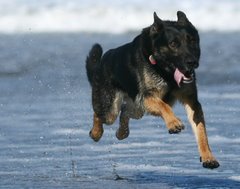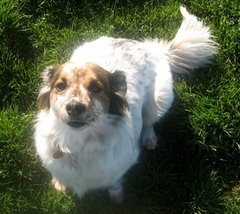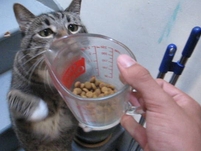
Thursday, January 7, 2010
Training Tip: Unwanted Barking

Thursday, December 31, 2009
January 2010 is Train Your Dog Month!

The Association of Pet Dog Trainers has declared January 2010 as Train Your Dog month. Many dogs found new homes over the holidays. Let's get started training them, so they can stay in those homes! I will be posting training tips throughout the month, but feel free to email me or comment if you have any questions: romanizmydog at yahoo dot com.
Friday, December 25, 2009
Paws for Peace

Whether you celebrate the holidays or not, it is always a good time to pause and reflect on the simple joys in life. What better way to spend a gorgeous Christmas day than at Ft. Funston with good friends and good dogs? Wishing you all a New Year filled with peace and a better understanding of our canine companions. We focus so much on what we need or have to teach them, or bad behaviors we must break, that we forget what they have to teach us: the simple joy of being alive in the moment! (click on photo for larger image)
Friday, December 11, 2009
Reliable Off Leash Control Starts with a Solid Foundation Part I

Many clients come to dog trainers with one goal in mind, "I just want my dog to come when I call him off leash!"
Saturday, August 15, 2009
Gentle Leaders: Not so Gentle
Head halters (Gentle Leader, Halti) have gained in popularity over the years as the perfect, non-abusive way to train your dog not to pull on leash. The dog training world is so fragmented these days, it's hard to figure out which "tool" to use or "method" to follow. Head halters, along with no pull harnesses, are popular with positive only trainers (I will define a positive only trainer as one who concentrates on bringing about good behavior through the use of positive reinforcement-rewarding with food, toys, etc. while ignoring bad behavior and avoiding the use of aversives such as a collar correction). If you put a bunch of dog trainers in a room and start talking about training collars, without a doubt the controversy over head halters vs. other types of collars will spark quite the debate.
People often ask me why I do not use or recommend head halters in training. After all, they work on even the most powerful dogs with the owner barely pulling on the leash. I do not doubt they work on most dogs but I am convinced they are not a training tool and provide marginal management at best.
I don't like or use the gentle leader for several reasons:
1. Dogs hate it.
Why do they hate it? It gives constant pressure around their muzzle if they even slightly move forward, and, since a dog's muzzle is extremely sensitive (unlike his neck), this is uncomfortable in the least. Why would I put something on my dog he obviously finds immediately aversive? If I won't put it on my dogs (and I have used it on both of them), I'm certainly not going to recommend it to a client.
2. The potential for injury and misuse are considerably high-imo, higher than with a prong collar. Injuries associated with the head harness include cervical injuries due to the torquing of the neck if the dog lunges, for example. I've also seen people correcting dogs with the GL (giving leash tugs/pops). In the GL insert material, it even tells owners how to tug upwards to get the dog to sit. One positive only training class I took many years ago, said we could 'gently' pull the dog's head towards us to make him look at us.
3. It's advertised as 'scientific and positive' based on how a 'pack leader' or mother wolf firmly grasps a subordinate wolf around the muzzle. First of all, when dogs or wolves do this, it is a quick correction...not a constant source of pressure & aggravation at best or pain at worst. The GL material also states they got the idea from how equestrians handle horses with halters and that equestrians don't use prong collars on a horse's neck. This is true but look at the physiology of a horse's (a prey animal, btw) head. Also, equestrians may not use prongs, but they most certainly use various metal bits in a horses's mouth to gain control when riding. Very few equestrians ride untrained horses in halters! Bottom line...Dogs are not horses.
4. Head Halters are not a training device at all. They are a management tool (and I am not against management tools while owners learn the skills they need to change their dog's behavior, but this is one I avoid as it rarely leads to success-a dog who does not pull while not wearing it!) only and it's very difficult to transfer from a GL to a regular flat collar. I have never had that problem with a prong.
I've used GLs and haltis on my own dogs and seen the result of their use on countless others. They either completely shut down (no matter how many treats or time I gave them to get used to the halter) or fought it. I have not had that reaction with any other type of training collar. Why would I use something on my dog that he immediately finds aversive? I choose not to use it or recommend it to clients. Of course, some dogs will not find it aversive, but usually those are not the dogs that I see for training!
Friday, August 7, 2009
the Power of Praise
Human nature tends to focus more when things are going wrong. Whether it be the car not starting, your child not cleaning his room, someone cutting in front of you in line or the dog chewing the leg off Grandma's antique dining table. These events usually call us to action. Believe it or not, dogs are similar. Everything is copascetic until it is not, then they will let the offender know under no uncertain terms! By conserving energy, and reacting only when something is wrong in the environment, both canine and human species have survived and thrived.
My little mixed breed, Tikka, does not go around giving Roman, my German shepherd, treats every time she catches him being good (for Tikka, 'being good' means, basically, stay out of my face and away from my stuff!). She never 'praises' Roman for not eating her food, chewing her toy or staying off her bed. How did Roman figure out what he could and could not do around her? By trying to do what he wanted to do, then getting nailed with an air snap and growl. She only had to do it once, her timing was so good, and now the two dogs live in perfect harmony. If Roman 'gets out of line', Tikka only need to give him 'the look' and he backs off.
Understanding this aspect of a dog's nature can go a long way when training your dog. Human society has evolved and most people live pretty cushy lives. Many dogs live cushier lives than many people! If you are reading this blog, you and your dog are probably not worrying about your next meal or being a next meal. In order to live in harmony in our modern human world, I believe dogs need to know what not to do, and this can be taught in a fair and kind way. BUT, dogs also need to know what TO do and this is where many people have trouble. Owners can learn how to motivate and reward their dog for doing the right thing. This is where praise comes in. Verbal praise is one form of reward to let your dog know when she has done the right thing and to motivate her to work with you. While I do use other types of rewards (food, toys and games) during the learning stage of training, I always make sure my clients understand the power of verbal praise when working with their dog. It is impossible to be consistent with treats and toys, but you always have your voice. Once a dog learns a behavior, we gradually reduce the use of treats but we always maintain the verbal praise. Praising your dog when he does something right increases the liklihood that he will do that behavior. This may seem so obvious and simple, but not so easy to remember when working our dog out in the real world (see second paragraph!). (a note about physical praise or petting. This type of praise can be overstimulating for some dogs, like my dog, Roman. On the other hand, if you have a dog that needs more encouragement, a nice pat in addition to verbal encouragement can help motivate him...a good dog trainer can help you figure out what type of praise works best for your dog and how to use your voice & timing to praise appropriately).
So, next time you have your dog out for a walk, try praising him to the high heavens every time he looks to you. Don't just say a flat, "goodboy", say, "WHAT a GOOD boy you are! That's IT! LOOK at YOU!" If off leash, don't give him any commands but tell him he is AWESOME every time he comes running up to you. If your dog is lying down and calm at home, tell her she is sooo very good. Be your dog's cheerleader and don't worry if strangers think you are nuts. By the way, this works with human children, too! In my elementary school classroom, I hand out 'caught being good' cards when I catch students making the right choices. I believe dogs are also emotional beings and when an owner tells her dog "Good job!", that's usually all it takes to get the energy flowing in a positive direction with a tail wag.
http://www.angelacasey.com/
Sunday, August 2, 2009
Dog Days of Summer











 Everest, the Tibetan spaniel who has been staying with me for 2 weeks now, did great at yesterday's Giants game vs. the Phillies. It was AT&T park's annual Dog Days of Summer and dogs are allowed (after buying a 'special' ticket) in the bleachers. There were 650 dogs there to watch Lincecum pitch a winning game. Tim Lincecum's own French bulldog, Cy, got to play and watch the game from the clubhouse.
Everest, the Tibetan spaniel who has been staying with me for 2 weeks now, did great at yesterday's Giants game vs. the Phillies. It was AT&T park's annual Dog Days of Summer and dogs are allowed (after buying a 'special' ticket) in the bleachers. There were 650 dogs there to watch Lincecum pitch a winning game. Tim Lincecum's own French bulldog, Cy, got to play and watch the game from the clubhouse.I was grateful to Everest for warming my lap (he got bored by the 6th inning, and fell asleep) since the San Francisco "summer" yielded cold fog and wind. The dogs didn't seem to mind.





